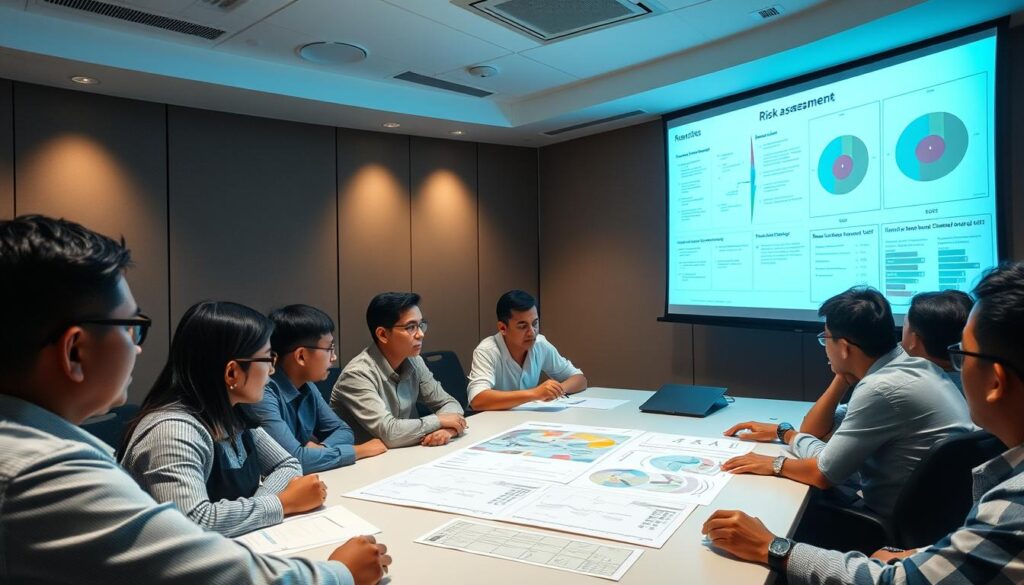What if the key to unlocking your organization’s potential lies not in maximizing opportunities but in effectively managing risks? In today’s fast-paced business environment, understanding how to align risk management with organizational goals is crucial for any successful leader. Strategic risk management goes beyond mere compliance; it enhances decision-making, promotes resilience, and allows businesses to seize growth opportunities while keeping potential threats at bay. In this article, we explore the basics of risk management and governance and how they can be linked with your organization’s goals. This sets you on a path to sustained success.
Key Takeaways
- Discover the importance of aligning risk management with organizational objectives.
- Learn how strategic risk management can enhance decision-making.
- Understand the role of governance in effective risk management.
- Explore methods for identifying and prioritizing risks.
- Review ways to monitor and adjust risk strategies over time.
- Utilize key performance indicators (KPIs) to gauge effectiveness.
Introduction
The business world is always changing, and managing risks is key. Companies face many risks that can affect their success. It’s important to link risk management to the company’s goals to handle these threats well.
A strong risk management plan protects a company’s assets. It also helps the company stay focused and succeed. Studies by firms like McKinsey & Company show that good risk management leads to better revenue and a competitive edge.
When risk management is aligned with the company’s goals, it improves decision-making. This focus on goals is the starting point for understanding risk management better.

Understanding Risk Management Strategy
Knowing how to manage risks is key for any business wanting to succeed. It begins with risk identification, where we find out what threats and weaknesses exist. By spotting these risks, companies can get ready for any challenges that might come their way.
The next important step is risk assessment. Here, we look at how likely each risk is and how it could affect our goals. By ranking risks, we focus on the biggest threats first.
After assessing risks, we move to risk mitigation. This is where we create plans to lessen the harm risks can cause. By making these plans fit each risk, we stay flexible and strong.
Lastly, keeping an eye on risks is crucial. By watching for new risks and their effects, we can adjust our plans as needed. This keeps us ready for any problem that might come up.

Identifying Organizational Objectives
Setting clear organizational objectives is key to linking risk management with business goals. These goals must be well-defined to help set targets effectively across the organization. It’s important to involve all stakeholders to make sure the goals are Specific, Measurable, Attainable, Relevant, and Timely.
These objectives guide risk management, making it crucial to share them with all departments. When goals are clear, it’s easier to focus on risks that affect these goals. This helps businesses use their resources better to tackle potential threats.
Aligning teams around these objectives builds a culture where everyone knows their part in achieving goals. By integrating these principles into the business, organizations can better align their risk strategy with their goals. This leads to stronger risk management processes.
Assessing and Prioritizing Risks
Organizations can manage risks well by using the right methods. They use both qualitative and quantitative methods to understand threats. Risk matrices help them see risks clearly and make better decisions.
It’s key to rank risks to know which ones need urgent action. Risks that could harm operations a lot should be tackled first. This way, businesses can use their resources wisely, which is vital in the Philippines’ competitive market.
| Risk Type | Likelihood (1-5) | Impact (1-5) | Risk Score | Priority |
|---|---|---|---|---|
| Cybersecurity Breach | 4 | 5 | 20 | High |
| Supply Chain Disruption | 3 | 4 | 12 | Medium |
| Regulatory Changes | 2 | 4 | 8 | Low |
| Natural Disasters | 5 | 4 | 20 | High |

By focusing on the most critical risks, businesses can better handle complex situations. They become more resilient against unexpected problems.
Developing Risk Mitigation Strategies
Creating effective risk mitigation strategies is key for any organization. It helps align risk management with the company’s goals. This involves a detailed approach to assess risks and improve operational efficiency.
Using proactive planning is essential. It lets organizations see challenges ahead and tackle them directly.
Examples of Aligned Risk Mitigation Strategies
Many companies have found success with risk mitigation strategies that fit their needs. Here are some examples:
- Incorporating Advanced Technologies: Using AI and machine learning can boost efficiency. These tools handle routine tasks, freeing up teams for strategic work.
- Regulatory Compliance Frameworks: Setting up frameworks for industry standards reduces regulatory risks. This aligns with proactive planning to avoid legal issues that could slow growth.
- Due Diligence in Mergers and Acquisitions: Thorough due diligence is crucial in acquisitions. It helps spot potential problems. This is a key part of aligning risk strategies with long-term goals.

Risk Management & Governance
Effective risk management is key for organizations aiming to reach their goals. Clear governance helps align risk practices with overall objectives. This is crucial for making strategic decisions that consider both chances and dangers.
Leaders have a big role in managing risks. Senior management and board members need to discuss and shape risk policies. This ensures policies match the organization’s risk tolerance. Leaders who are open and accountable build trust and a culture that values risk awareness.
Having a solid risk management plan helps organizations deal with unknowns and innovate. Leaders should talk openly about risks, seeing them as part of the journey, not hurdles. This approach helps organizations prepare for challenges and adjust strategies as needed, ensuring they stay strong over time.
Monitoring, Reviewing, and Adjusting Strategies
Effective risk management means always watching and adjusting strategies. Companies face a world where things change fast. They must keep improving their risk management to stay on top.
By watching closely, businesses can see if their plans are working. They check important numbers and results to find where they can get better. This helps them act fast when new risks show up.
Companies should set times to check their risk plans. They might do this every few months or once a year. In these meetings, they talk with others to get their thoughts and make changes. This makes everyone feel involved and helps improve things.
| Review Frequency | Purpose | Action Steps |
|---|---|---|
| Quarterly | Immediate adjustments | Conduct stakeholder meetings, analyze recent incidents, identify emerging risks |
| Semi-Annual | Mid-term strategy evaluation | Review strategic outcomes, compare with objectives, adjust risk thresholds |
| Annual | Comprehensive assessment | Engage in detailed performance analysis, reinforce strategic alignment, outline next year’s plan |
Adding feedback into the review process makes risk management better. Companies that watch closely and adjust plans are ready for surprises.
Utilizing Key Performance Indicators (KPIs)
Key Performance Indicators (KPIs) are key in checking if risk management works well. Companies need to pick and use KPIs that match their goals. These metrics show how well they’re doing and help them keep up with industry standards.
By using benchmarking, businesses can learn a lot about their risk management. Checking KPIs often helps them see how they’re doing over time. They can spot trends and areas that need work. This helps them make better changes and stay strong against risks.
| KPI | Description | Importance |
|---|---|---|
| Risk Reduction Rate | Measures the effectiveness of strategies designed to mitigate risks. | Indicates success in reducing potential threats, enhancing overall safety. |
| Incident Response Time | The time taken to address and resolve identified risks or incidents. | Quick response times can minimize damage and maintain operational continuity. |
| Compliance Rate | Tracks adherence to relevant laws, regulations, and internal policies. | Ensures organizational governance and reduces legal risks. |
| User Trust Score | Assesses the level of confidence stakeholders have in the organization’s risk management efforts. | High trust scores can enhance reputation and business relationships. |
It’s important to check risk management often. Detailed analyzing KPIs helps with following rules and being ready for new challenges.
Conclusion
In today’s fast-changing business world, risk management is key, more so in the Philippines and Southeast Asia. Companies that link their risk plans to their main goals do better. They can handle tough challenges more easily.
Knowing how to spot, assess, and tackle risks is crucial. It helps businesses stay strong and ready for surprises. A good plan for managing risks makes a company more effective and resilient.
By making risk management a part of their strategy, companies can grow and stay strong. This approach is not just about following rules. It’s a way to achieve big goals in a changing market.

